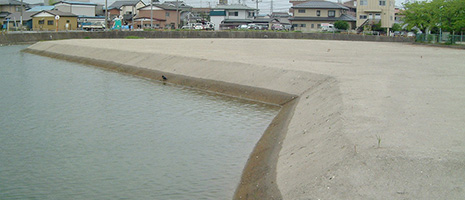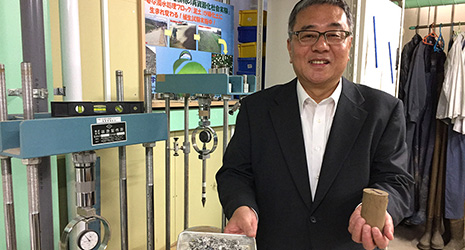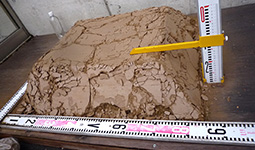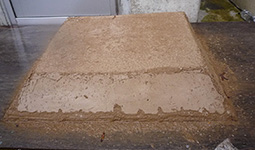Home > Highlighting JAPAN > Highlighting Japan February 2017 > Science & Technology
Highlighting JAPAN


Mud, Mud, Glorious Mud
An innovative mud conditioning technology is being employed on a wide scale in reconstruction work following the Great East Japan Earthquake.
Sludge contained in watery mud or accumulated underwater has not previously been used as a material to elevate land for the construction or development of roads, levees or building lots, among other things, as this mud cracks and breaks easily when it dries.
Mori Institute for Environmental Technology, which is located in Shinjo, Yamagata Prefecture, developed the Bon Terrain method to recycle mud into a material that can be used securely for land elevation. This mud recycling technology is the achievement of more than twenty years’ research and development conducted primarily by Masato Mori, the director of Mori Institute for Environmental Technology, and Hiroshi Takahashi, a professor at the Graduate School of Environment Studies of Tohoku University.
“It is very troublesome to deal with mud during civil engineering works. It needs to be removed to create the foundations of buildings. On top of that, it is difficult to recycle it for refilling or land elevation,” says Mori. “Consequently, it has been usual to pay disposal fees to discard drenched mud and purchase the necessary amount of soil and sand for civil engineering works.”
To improve the structure of mud, the Bon Terrain method uses a fibrous mud conditioning material called “Bon Fiber,” which is made from specially processed waste newspaper as well as a cement-based curing agent.
When the two materials are injected into mud and mixed with it, the useless waste soil is transformed into a material whose quality is good enough to be used for land elevation. This is attributable to the excellent bond strength generated as a result of the complex blend of the fibrous agents contained in the Bon Fiber with mud particles. The erosion resistance (resistance to water erosion) of mud improved through the Bon Terrain method is approximately 10,000 times that of ordinary sandy soil (mud containing a greater proportion of sand).
The Bon Terrain method was proven to be very effective in the reconstruction works following the Great East Japan Earthquakes that occurred in 2011. The tsunami generated by the Great Earthquake quickly flowed up rivers in Miyagi and Fukushima, the prefectures adjacent to Yamagata where Mori Institute for Environmental Technology is located, causing inundations in many places. It also brought a large amount of sludge with it. Additional flood damage was very likely to occur due to heavy rainfalls and other disasters unless the rivers were dredged and levees were elevated as soon as possible.
“The Bon Terrain method was indispensable for the work for achieving a rapid recovery from the Earthquake, because it improves the structure of mud dredged from riverbeds on the spot so that it can be utilized for land elevation,” says Mori. “With no additional expenses required for purchasing soil and discarding drenched mud, we also succeeded in reducing the large cost of land elevation compared to conventional methods.”
In addition, it was confirmed that liquefaction did not occur at all in the levees that had been built using the Bon Terrain method in Fukushima before the Great East Japan Earthquake, despite the strong tremors hitting them.
Today, the number of Bon Terrain method-based construction works totals 400 (630,000 cubic meters in terms of volume) in Japan, centered on the Tohoku Region that suffered significant damage in the Great East Japan Earthquake. The method has received a number of awards, including the METI (Minister of Economy, Trade and Industry) Minister’s Prize at the sixth Monodzukuri Nippon Grand Award 2015 in recognition of its contributions to curb environmental loads and reduce civil works costs by recycling mud that was previously worthless.
It used to be impossible to carry mud, which contains a lot of water, without using special vehicles such as vacuum trucks. However, waste soil improved using the Bon Terrain method can be carried by dump trucks or sand barges.
“We currently recycle mud on site. Going forward, we expect that we will more often see mud being removed from one location to be recycled in another location for land elevation,” says Mori. “We have tested a range of materials, but we have been unable to find better mud conditioning materials than Bon Fiber. The number of inquiries from overseas for technology transfer has recently increased rapidly. Going forward, we will respond to these inquiries proactively.”
© 2009 Cabinet Office, Government of Japan








